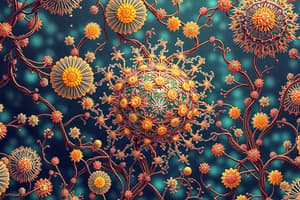Podcast
Questions and Answers
How does surface area affect reaction rate inside the cell?
How does surface area affect reaction rate inside the cell?
Small cells have a small volume and high surface area to volume ratio, allowing materials to move quickly across the cell membrane and making them more efficient.
What kind of cells have a greater reaction rate?
What kind of cells have a greater reaction rate?
Small cells
Why are large cells inefficient?
Why are large cells inefficient?
Large cells cannot grow beyond a certain size and have a small surface area which creates bottlenecks in the absorption of materials.
What is the location and function of cristae?
What is the location and function of cristae?
What is the location and function of alveoli?
What is the location and function of alveoli?
What is the location and function of microvilli?
What is the location and function of microvilli?
What is the location and function of nephrons?
What is the location and function of nephrons?
What is the location and function of brain folds?
What is the location and function of brain folds?
What is the location and function of dendrites?
What is the location and function of dendrites?
What is the location and function of the tongue/taste buds?
What is the location and function of the tongue/taste buds?
Study Notes
Surface Area to Volume Ratio in Cells
- Smaller cells possess a higher surface area to volume ratio, enhancing efficiency in transporting materials across the cell membrane.
- Larger cells experience slower material movement due to a lower surface area to volume ratio caused by volume increasing faster than surface area.
- Small cells are more efficient in reaction rates compared to larger ones.
Inefficiency of Large Cells
- Large cells are limited in size due to the requirement for substantial resources.
- A small surface area leads to bottlenecks in material absorption, hindering necessary exchanges at the cell membrane.
Cristae
- Located in the mitochondria
- Function to increase surface area for enhanced ATP production.
Alveoli
- Tiny sacs found in the lungs
- Serve to maximize the area available for gas exchange (oxygen and carbon dioxide).
Microvilli
- Located in the small intestines
- Increase surface area to facilitate food absorption during digestion.
Nephrons
- Microscopic tubes situated in the kidneys
- Increase surface area dedicated to the transport and filtration of urine and blood.
Brain Folds
- Located within the brain
- Expand the surface area for nerve tissues, aiding in the transmission of nerve impulses.
Dendrites
- Finger-like extensions on nerve cells
- Increase surface area to enhance the transmission of nerve impulses.
Tongue and Taste Buds
- Located in the mouth
- Serve to moisten food, facilitating digestion.
Studying That Suits You
Use AI to generate personalized quizzes and flashcards to suit your learning preferences.
Description
Explore the impact of surface area on reaction rates in cells with this flashcard quiz. Understand how cell size influences efficiency and material exchange across the membrane. Perfect for revising key concepts in cell biology.




